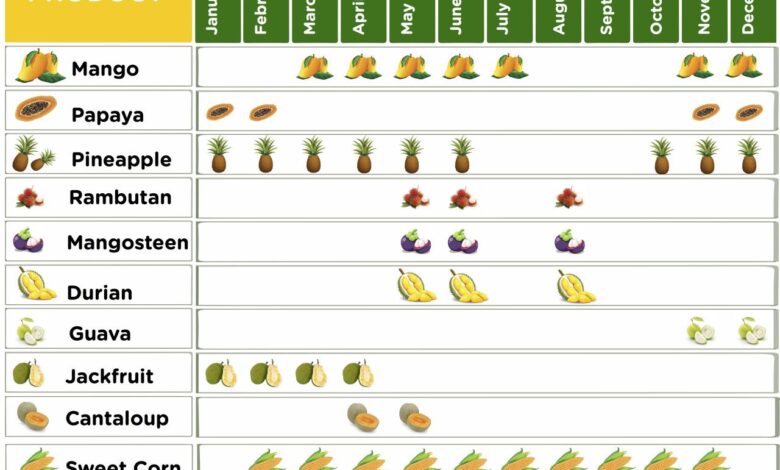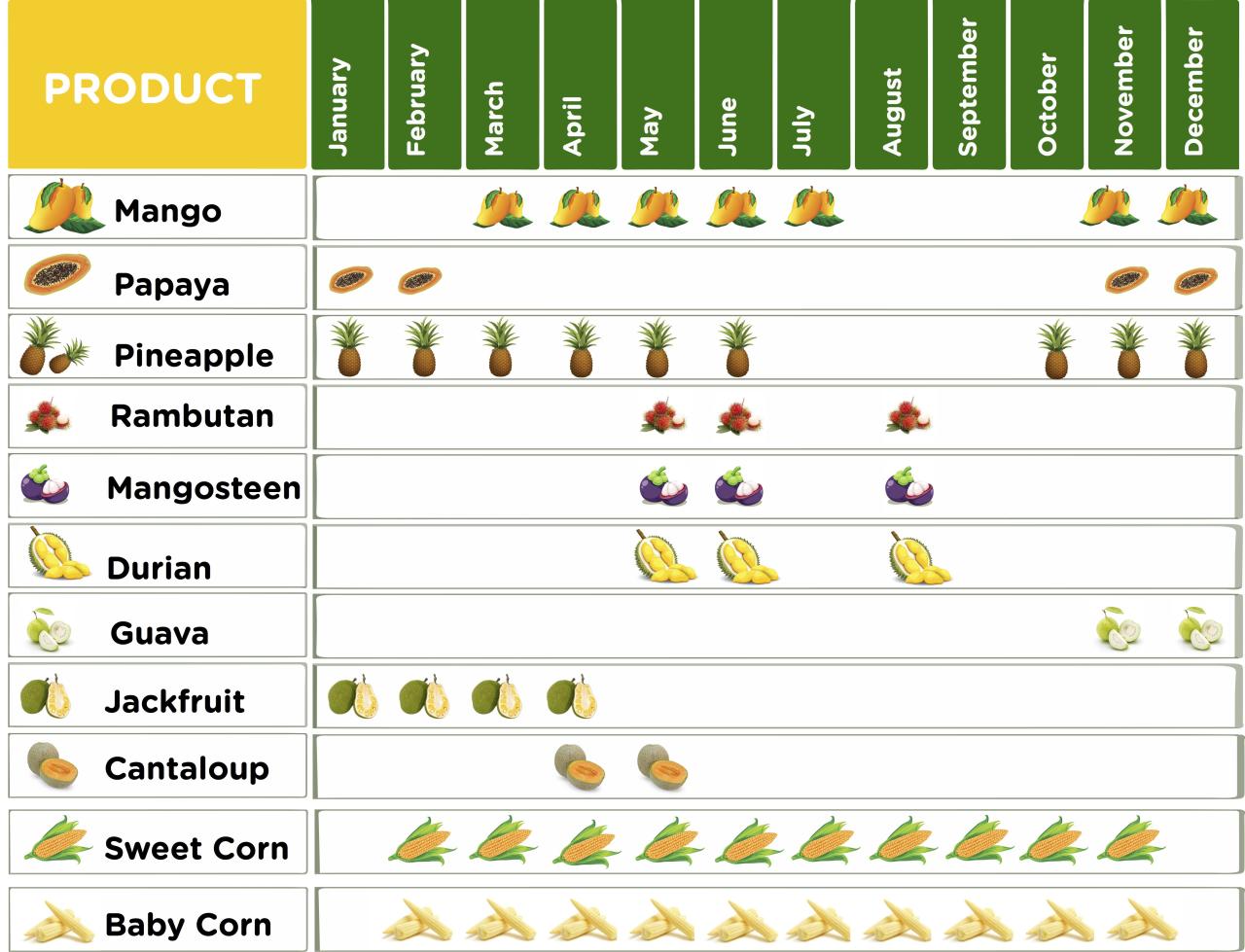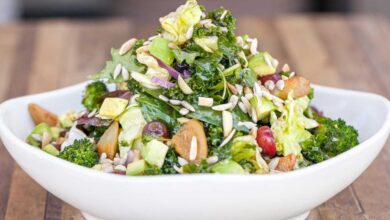
Fruits and Veggies to Eat at Their Seasonal Peak Right Now
Fruits and veggies to eat at their seasonal peak right now – it’s not just a trend, it’s a delicious and healthy way to enjoy nature’s bounty! When fruits and vegetables are in season, they’re bursting with flavor, packed with nutrients, and often more affordable.
Imagine biting into a juicy, sun-ripened peach or savoring the sweet crunch of a crisp apple, knowing that it’s at its peak of perfection. That’s the magic of seasonal eating!
From vibrant berries to hearty root vegetables, there’s a world of seasonal delights waiting to be discovered. This guide will help you navigate the seasonal calendar, uncover the best fruits and veggies to enjoy right now, and learn how to incorporate them into your meals for a flavorful and nutritious experience.
Seasonal Delights: Unveiling the Best Fruits and Veggies Right Now
There’s a reason why our grandmothers always emphasized eating seasonally. Fruits and vegetables at their peak ripeness are not only bursting with flavor but also packed with nutrients. This is because they’re harvested at the perfect time, when their sugar content is highest and their vitamins and minerals are at their peak.
Right now, it’s the perfect time to load up on juicy watermelon, sweet peaches, and vibrant bell peppers – all bursting with flavor and nutrients. But as you savor these seasonal delights, remember to fuel your body wisely! If you’re experimenting with intermittent fasting, make sure you’re avoiding common pitfalls.
Check out this helpful guide on 6 intermittent fasting mistakes to avoid to maximize your results. And with a healthy approach to fasting, you can enjoy those delicious summer fruits and veggies guilt-free!
Fruits and Vegetables in Season
Enjoying seasonal produce offers a plethora of benefits, including:
- Enhanced Flavor and Nutrition:Peak-season fruits and vegetables are at their most flavorful and nutrient-rich.
- Reduced Environmental Impact:Locally sourced, seasonal produce reduces transportation distances, minimizing carbon footprint.
- Support Local Farmers:Buying seasonal produce directly from local farmers helps support their livelihoods.
- Variety and Abundance:Each season brings a unique array of fresh produce, offering a diverse culinary experience.
Seasonal Produce by Region
The availability of seasonal produce varies depending on the region. Here’s a glimpse of popular fruits and vegetables in season across different parts of the world:
North America
| Month | Fruits | Vegetables |
|---|---|---|
| July | Berries (strawberries, blueberries, raspberries), peaches, nectarines, watermelon, cantaloupe | Corn, tomatoes, zucchini, cucumbers, peppers, eggplant |
| August | Apples, pears, grapes, plums, figs | Green beans, broccoli, cauliflower, squash, onions |
Europe
| Month | Fruits | Vegetables |
|---|---|---|
| July | Cherries, apricots, peaches, plums, melons | Tomatoes, cucumbers, zucchini, peppers, eggplant |
| August | Grapes, figs, apples, pears | Beans, broccoli, cauliflower, cabbage, carrots |
Asia
| Month | Fruits | Vegetables |
|---|---|---|
| July | Mangoes, lychees, dragon fruit, watermelons, pineapples | Eggplant, okra, green beans, cucumbers, peppers |
| August | Grapes, pomegranates, figs, bananas | Tomatoes, potatoes, onions, garlic, ginger |
Flavors of the Season: A Culinary Journey
The peak season for fruits and vegetables is a time to celebrate the bounty of nature’s harvest. Not only are these ingredients at their freshest and most flavorful, but they also offer a wide range of culinary possibilities. This is the time to savor the unique characteristics of each ingredient, to unlock the secrets of their flavor profiles, and to embark on a culinary journey that will tantalize your taste buds.
Flavor Profiles of Seasonal Fruits and Vegetables, Fruits and veggies to eat at their seasonal peak right now
The flavors of seasonal fruits and vegetables are a symphony of sweetness, acidity, bitterness, and umami. The interplay of these flavors creates a unique taste experience that is both refreshing and satisfying. For example, summer peaches are known for their delicate sweetness and juicy texture, while autumn apples offer a crisp bite and a range of flavors from tart to sweet.
Likewise, the earthy flavors of root vegetables like carrots and beets complement the bright acidity of citrus fruits like lemons and limes. These diverse flavor profiles offer endless possibilities for creating delicious and satisfying dishes.
Seasonal Recipes
Seasonal fruits and vegetables provide a canvas for culinary creativity. Their vibrant flavors and textures lend themselves to a variety of cooking techniques, from simple salads to complex desserts.
| Dish | Ingredients | Preparation |
|---|---|---|
| Summer Peach Salad | Peaches, fresh basil, goat cheese, balsamic vinaigrette | Slice peaches, toss with basil, goat cheese, and vinaigrette. |
| Apple and Cranberry Crisp | Apples, cranberries, cinnamon, oats, butter | Combine apples, cranberries, and cinnamon in a baking dish. Top with a mixture of oats, butter, and sugar. Bake until golden brown. |
| Roasted Carrot and Beet Salad | Carrots, beets, olive oil, lemon juice, parsley | Roast carrots and beets until tender. Toss with olive oil, lemon juice, and parsley. |
Preparing Seasonal Fruits and Vegetables for Optimal Flavor and Texture
To maximize the flavor and texture of seasonal fruits and vegetables, it’s essential to prepare them properly. Here are some tips:* Choose ripe fruits and vegetables:Select fruits and vegetables that are firm, free of blemishes, and have a vibrant color.
Store properly
Right now, the markets are bursting with juicy stone fruits like peaches and plums, along with crisp bell peppers and vibrant zucchini. But when it comes to these seasonal treasures, it’s a question that often pops up: is it healthier to eat them raw or cooked?
You might be surprised to learn that the answer depends on the specific vegetable, as explained in this helpful article on whats healthier raw or cooked veggies. Ultimately, the key is to enjoy these peak-season ingredients in ways that suit your taste and dietary needs.
Right now, we’re in the heart of citrus season, with juicy oranges, tangy grapefruits, and sweet mandarins bursting with flavor. These bright fruits, along with hearty root vegetables like carrots, parsnips, and beets, are perfect for adding a burst of color and nutrients to your meals.
As you plan your holiday feasts, remember that incorporating these seasonal gems can help you build a healthier holiday plate that’s both delicious and good for you. So, get creative and explore the vibrant flavors of the season!
Wash thoroughly Wash fruits and vegetables thoroughly under cold running water to remove dirt and debris.
Use appropriate cooking methods Choose cooking methods that will enhance the flavor and texture of each ingredient. For example, grilling brings out the sweetness of peaches, while roasting intensifies the earthy flavors of root vegetables.By following these tips, you can ensure that your seasonal fruits and vegetables are at their peak of flavor and texture, making your dishes truly delicious and satisfying.
Nutritional Powerhouses

The seasonal bounty of fruits and vegetables is not only delicious but also a treasure trove of essential nutrients that support our overall well-being. This season, let’s delve into the nutritional benefits of these vibrant ingredients and understand how they contribute to our health.
Nutritional Breakdown
The following table highlights the vitamin and mineral content of some of the featured seasonal fruits and vegetables.
| Fruit/Vegetable | Vitamins | Minerals |
|---|---|---|
| Apples | Vitamin C, Vitamin K, Potassium | Fiber, Potassium, Vitamin C |
| Broccoli | Vitamin C, Vitamin K, Vitamin A | Fiber, Potassium, Calcium |
| Pumpkins | Vitamin A, Vitamin C, Vitamin K | Fiber, Potassium, Magnesium |
| Spinach | Vitamin A, Vitamin C, Vitamin K | Fiber, Potassium, Iron |
| Sweet Potatoes | Vitamin A, Vitamin C, Vitamin B6 | Fiber, Potassium, Magnesium |
Potential Health Benefits
The vitamins, minerals, and antioxidants found in these seasonal fruits and vegetables offer a wide range of potential health benefits:
- Boosting Immunity:Vitamin C, found in apples, broccoli, and pumpkins, is a potent antioxidant that helps strengthen the immune system, protecting against infections and illnesses.
- Promoting Digestive Health:The high fiber content in these fruits and vegetables supports healthy digestion, preventing constipation and promoting regular bowel movements.
- Maintaining Healthy Vision:Vitamin A, abundant in pumpkins, spinach, and sweet potatoes, is crucial for maintaining good vision and protecting against age-related macular degeneration.
- Supporting Heart Health:Potassium, present in apples, broccoli, pumpkins, spinach, and sweet potatoes, helps regulate blood pressure and reduce the risk of heart disease.
- Managing Blood Sugar Levels:The fiber and complex carbohydrates in these seasonal choices can help regulate blood sugar levels, making them beneficial for individuals with diabetes or those seeking to manage their blood sugar.
Seasonal Shopping: Fruits And Veggies To Eat At Their Seasonal Peak Right Now
Finding the freshest, most flavorful fruits and vegetables is a key part of enjoying the bounty of the season. Whether you’re heading to a bustling farmers’ market or browsing the produce aisles at your local grocery store, a little knowledge can go a long way in ensuring you get the best quality produce.
Farmers’ Markets: A Direct Connection to the Source
Farmers’ markets offer a unique opportunity to connect directly with the people who grow your food. This direct connection allows you to learn about the growing practices, varieties, and even the stories behind the produce you’re purchasing. Farmers’ markets often feature a wide variety of seasonal fruits and vegetables that you might not find in traditional grocery stores.
- Look for signs of freshness:The produce should look vibrant and free of blemishes. Ask the farmers about their growing practices and any tips they have for storing the produce.
- Talk to the farmers:Engage in conversation with the farmers. Ask about their farming methods, the varieties they offer, and any tips for selecting and storing their produce.
- Consider buying in season:Farmers’ markets are a great place to find seasonal produce at its peak. Ask the farmers about what’s in season and what they recommend.
- Support local farmers:By shopping at farmers’ markets, you are directly supporting local farmers and their businesses. This helps to strengthen the local food system and ensures access to fresh, high-quality produce.
Grocery Store Selection: Tips for Quality Produce
Even if you can’t always make it to a farmers’ market, there are ways to select high-quality produce at your local grocery store.
- Inspect for freshness:Look for vibrant colors, firm textures, and no signs of bruising or decay.
- Check the leaves:For leafy greens, look for vibrant green leaves that are free of wilting or yellowing.
- Smell the produce:Fruits and vegetables should have a fresh, pleasant aroma. Avoid produce that smells sour or musty.
- Avoid pre-cut produce:While convenient, pre-cut produce can lose its freshness faster. Opt for whole fruits and vegetables whenever possible.
- Consider organic options:Organic produce is grown without the use of synthetic pesticides or fertilizers. This can be a healthier and more sustainable choice.
Online Resources for Seasonal Produce
The internet is a valuable resource for finding information about seasonal produce. Several websites and apps provide detailed information on what’s in season, where to find it, and even recipes to inspire your culinary creativity.
- Seasonal Food Guide:This website provides a comprehensive guide to seasonal produce by region. You can find out what’s in season near you and get recipes and tips for using seasonal ingredients.
- Local Harvest:This website connects you with farmers’ markets and farm stands in your area. You can search by location and find information about the vendors, what they offer, and their operating hours.
- The Old Farmer’s Almanac:This almanac offers a wealth of information about seasonal produce, including planting and harvesting dates, as well as tips for storing and preserving your harvest.
Beyond the Plate
Seasonal produce isn’t just for eating—it’s a gateway to creativity! Explore the world of preserving, crafting, and decorating with the bounty of the season.
Preserving Seasonal Goodness
Preserving seasonal produce allows you to enjoy its flavors long after it’s out of season. Here are some popular methods:
- Freezing:This is a simple and versatile method for preserving fruits and vegetables. Simply wash, chop, and blanch (for vegetables) the produce before freezing in airtight containers or freezer bags. Frozen fruits can be used in smoothies, baked goods, or even eaten directly.
- Canning:This method involves preserving food in sealed jars by heating them to kill bacteria. It’s ideal for fruits like jams, pickles, and sauces. Follow tested recipes and ensure proper sterilization of jars for safe canning.
- Pickling:This involves preserving food in a brine or vinegar solution. Pickling is perfect for vegetables like cucumbers, onions, and peppers. The brine creates a tangy flavor and extends the shelf life of the produce.
Seasonal Recipes
Transform seasonal ingredients into delicious homemade treats:
- Strawberry Jam:Combine fresh strawberries, sugar, and lemon juice in a saucepan and simmer until thickened. This classic jam is perfect on toast, biscuits, or as a topping for yogurt.
- Tomato Chutney:A blend of chopped tomatoes, onions, garlic, ginger, and spices simmered in vinegar and sugar creates a sweet and tangy chutney. It’s a great accompaniment to grilled meats, curries, and cheese.
- Peach Salsa:Fresh peaches, red onions, cilantro, and jalapeno peppers are combined with lime juice and olive oil for a refreshing salsa. It’s delicious with grilled chicken, fish, or chips.
Decorative Uses for Seasonal Produce
Beyond the kitchen, seasonal produce can add a touch of natural beauty to your home:
| Produce | Decorative Use |
|---|---|
| Pumpkins | Carve jack-o’-lanterns, paint them, or use them as planters. |
| Apples | Create a festive centerpiece by arranging apples in a bowl or basket. |
| Gourds | Use them as decorative accents or paint them for a unique touch. |
| Corn husks | Weave them into wreaths or use them to create rustic decorations. |
Final Summary
Embracing seasonal eating is a journey of culinary exploration and a commitment to nourishing your body with nature’s finest. By choosing fruits and vegetables at their peak, you’re not only indulging in vibrant flavors and textures but also supporting sustainable farming practices and enjoying the full nutritional benefits of each ingredient.
So, take a bite of the season, experiment with new recipes, and discover the joy of eating fresh, local, and delicious produce.






